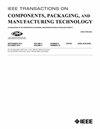Impact on Reliability of Microvoids and β-Sn Anisotropy in Flip-Chip Bumps
IF 2.3
3区 工程技术
Q2 ENGINEERING, ELECTRICAL & ELECTRONIC
IEEE Transactions on Components, Packaging and Manufacturing Technology
Pub Date : 2025-02-14
DOI:10.1109/TCPMT.2025.3542245
引用次数: 0
Abstract
The formation of small voids can occur in solder-based flip chip joints during the assembly process and a concern for certain applications that involve high electrical and thermal flux across the flip chip and also impact on electromigration (EM) in the joint. In this study, the impact of microvoids within flip-chip interconnections using Cu pillar bumps on EM resistivity was investigated. These microvoids can significantly affect the reliability of interconnections. To explore this, we intentionally created large voids in the solder bumps and measured the resulting differences in EM resistivity. The EM tests were conducted under specific conditions: at 150 °C and with a current density of 40 kA/cm2. Electron flow occurred in two directions—either from the Cu pad on the substrate side to the Cu pillar side (forward direction) or from the Cu pillar side to the substrate side (reverse direction). Surprisingly, the EM lifetime of interconnects with large voids was approximately 0.4 times shorter than that of interconnects with few or no voids, regardless of the electron flow direction. Further analysis by the simulation of current density distribution revealed that the presence of a 10-求助全文
约1分钟内获得全文
求助全文
来源期刊

IEEE Transactions on Components, Packaging and Manufacturing Technology
ENGINEERING, MANUFACTURING-ENGINEERING, ELECTRICAL & ELECTRONIC
CiteScore
4.70
自引率
13.60%
发文量
203
审稿时长
3 months
期刊介绍:
IEEE Transactions on Components, Packaging, and Manufacturing Technology publishes research and application articles on modeling, design, building blocks, technical infrastructure, and analysis underpinning electronic, photonic and MEMS packaging, in addition to new developments in passive components, electrical contacts and connectors, thermal management, and device reliability; as well as the manufacture of electronics parts and assemblies, with broad coverage of design, factory modeling, assembly methods, quality, product robustness, and design-for-environment.
 求助内容:
求助内容: 应助结果提醒方式:
应助结果提醒方式:


